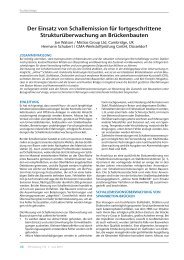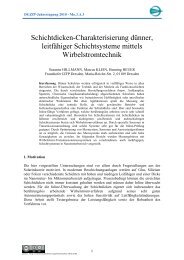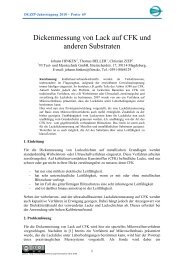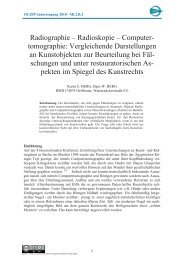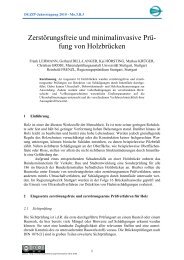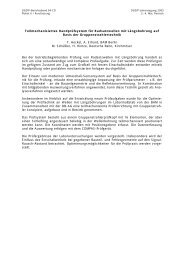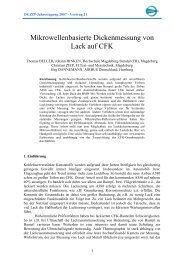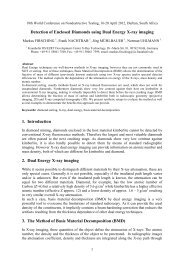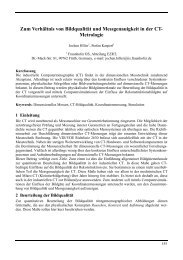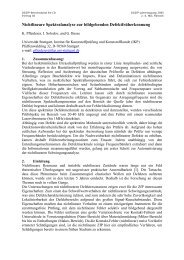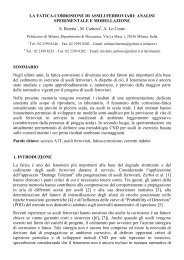The Early Use of Prussian Blue in Paintings - NDT.net
The Early Use of Prussian Blue in Paintings - NDT.net
The Early Use of Prussian Blue in Paintings - NDT.net
You also want an ePaper? Increase the reach of your titles
YUMPU automatically turns print PDFs into web optimized ePapers that Google loves.
"La mariée de village" and the "Embarkation to Cythera" represent earlier works by Watteau.<br />
Both pa<strong>in</strong>t<strong>in</strong>gs are conventionally dated to around 1710. This proves that Watteau already<br />
used <strong>Prussian</strong> blue <strong>in</strong> his earlier works. Assum<strong>in</strong>g that the stylistic dat<strong>in</strong>g <strong>of</strong> the pa<strong>in</strong>t<strong>in</strong>gs is<br />
correct, this means that <strong>Prussian</strong> blue must have found its way from Berl<strong>in</strong> to Paris <strong>in</strong> around<br />
1710. As mentioned above, Frisch sent a large amount <strong>of</strong> <strong>Prussian</strong> blue to Paris around 1714.<br />
However, he may have sent some smaller quantities long before this date.<br />
Düsseldorf / Rotterdam: Van der Werff Brothers<br />
Apart from Frisch, Dippel, who went to Holland <strong>in</strong> 1707 [Ackermann], or Dutch members <strong>of</strong><br />
the <strong>Prussian</strong> academy such as van Royen might have had the opportunity to <strong>in</strong>troduce the<br />
pigment to pa<strong>in</strong>ters <strong>in</strong> Holland. It is <strong>in</strong>terest<strong>in</strong>g <strong>in</strong> this context to follow the path <strong>of</strong> the van der<br />
Werff brothers Adrian and Pieter. <strong>The</strong>y worked <strong>in</strong> Düsseldorf and Rotterdam. <strong>The</strong> pa<strong>in</strong>t<strong>in</strong>g<br />
"Jacob bless<strong>in</strong>g the sons <strong>of</strong> Joseph" (Allen Memorial Art Museum, Oberl<strong>in</strong>) is the always<br />
mentioned <strong>in</strong> literature as pro<strong>of</strong> <strong>of</strong> Adrian van der Werff`s use <strong>of</strong> <strong>Prussian</strong> blue. Recent<br />
studies, however, have revealed that this pa<strong>in</strong>t<strong>in</strong>g was not f<strong>in</strong>ished by van der Werff himself,<br />
but by Henrik van Limborch <strong>in</strong> 1728 [Gaehtgens; Jansen]. <strong>The</strong>refore, Limborch might have<br />
been the one who used <strong>Prussian</strong> blue at a time when it was already very common.<br />
Sixteen pa<strong>in</strong>t<strong>in</strong>gs by Adrian van der Werff dat<strong>in</strong>g from 1705 to 1714 (collection <strong>of</strong> Bayrische<br />
Staatsgemäldesammlung, Munich, and SPSG) were analysed <strong>in</strong> cooperation with the Doerner<br />
Institute, Munich, Germany. No <strong>Prussian</strong> blue could be identified <strong>in</strong> these pa<strong>in</strong>t<strong>in</strong>gs.<br />
<strong>The</strong>refore, it appears that Adrian van der Werff was likely not among the first artists to use<br />
the pigment.<br />
However, <strong>Prussian</strong> blue could be identified <strong>in</strong> the pa<strong>in</strong>t<strong>in</strong>g "Entombment <strong>of</strong> Christ" (Picture<br />
Gallery, Potsdam, see figure 3) by Pieter van der Werff. <strong>The</strong> pa<strong>in</strong>t<strong>in</strong>g is signed “P van der<br />
Werff”, and is dated 1709. <strong>Prussian</strong> blue is used <strong>in</strong> the sky, and <strong>in</strong> Mary’s veil. This pa<strong>in</strong>t<strong>in</strong>g<br />
represents the earliest known pro<strong>of</strong> to date <strong>of</strong> the use <strong>of</strong> this pigment <strong>in</strong> a pa<strong>in</strong>t<strong>in</strong>g.<br />
Figure 3: Pieter van der Werff, " Entombment <strong>of</strong> Christ " (Picture Gallery, Sanssouci, Inv. No. GK I 10008)<br />
6



